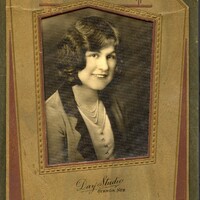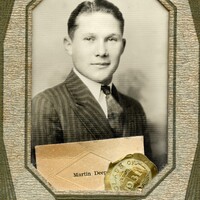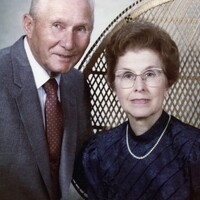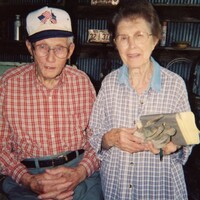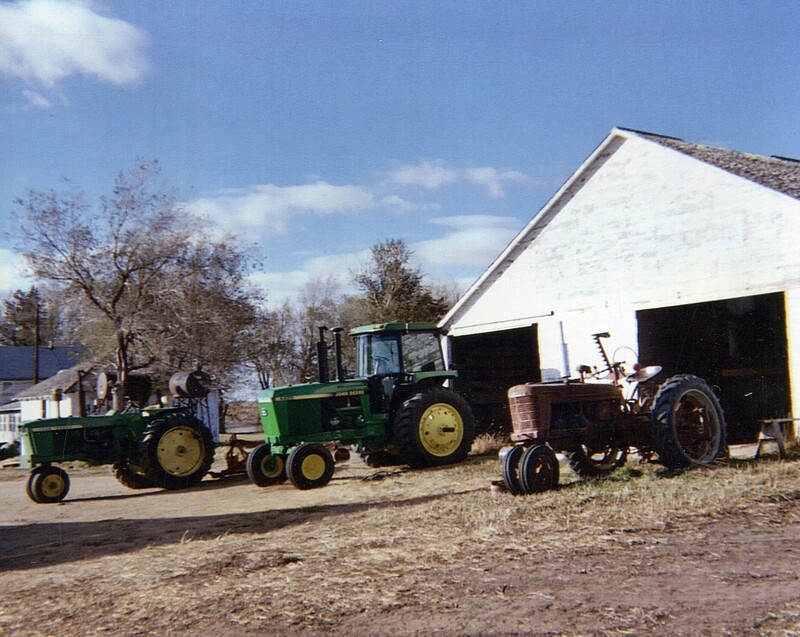"The Making of a Lipsticked Correspondent"
Martin and Doris Deepe struggled through–even personified–Nebraska’s family farm revolution for 69 years. It’s not exactly a life they envisioned upon graduating from high school. Nor did they even want that kind of future. Martin wanted to be a veterinarian; he loved animals, especially horses. Doris wanted a college education; she loved to research. But the Depression and Dust Bowl days pulverized their separate dreams.
In 1934, amidst the driest year on record, they were married in Kansas, having eloped across the border as did many young couples without funds for a wedding. A year later, they had their first daughter, Beverly Ann, and two years later came a second daughter, Barbara Joan, usually called Joan. The young couple yearned that their two little girls would have the advanced education denied to them.
Then, 50 years later, having lived through a lot of Nebraska’s farm revolution, the couple celebrated their wedding anniversary in a World War II Quonset hut that served as the community center in Belvidere, six miles from the county seat of Hebron in the geographic center of the country and near the rough ruts of the Oregon Trail.
But two years later, Martin suffered a fall that shattered his leg and required two surgeries; he continued to farm but walked in pain and later leased his farm land. Farming, one of the nation’s most dangerous occupations, had taken its toll. So, in 2003, 69 years after they began farming, Martin and Doris decided to sell their farm equipment and household items not already moved in 1996 to their new home in Hebron.
The farm equipment auction telescoped Nebraska’s farm revolution made during the couple’s 69 years. The last thing to be auctioned off was Martin and Doris’s equipment used when they were first married and farmed with horses, including horse-drawn two-bottom and three-bottom plows.) The sale bill casually listed these as “other older items for iron.”
In contrast, when Martin finished farming, he was using what he called his “big John Deere” (a 1990 John Deere 4456 tractor with powershift that he had used for 2,015 hours) and his “little John Deere” (a 1963 John Deere 3010 tractor using a single hydraulic standard shift). But he also held onto his first Farmall that he still used for cutting roadside weeds.
Martin once explained Nebraska’s quiet revolution to a dozen young journalists from mainland China, where a bloody revolution 40 year earlier had created the world’s most populous communist country and a U.S. enemy. (No one seemed aware of the bloody revolution in the Great Plains decades earlier when Native Americans were driven from their homeland.) The English-speaking Chinese were making fast notes and checking their tape recorders so that they could write a feature story for the University of Hawaii journalism class that Bev was teaching in 1988. They were also learning first-hand about what Bev had told them was an endangered species—the American family farmer—and the modernization of U.S. agriculture that had precipitated the decline.
Martin told the journalists that the revolutionary factor for his farming was a change of power. “In our childhood years and when I started farming, horses provided power for our equipment. I used horses for 10 years after we were married and then I got a gas Farmall tractor. That really revolutionized my farming because it was all-purpose; I didn’t need horses for planting, weeding or harvesting.”
The tractor also pulled a binder, which was used to cut oats or wheat and tie a string around them into an armload of straw and grain. Bev often helped gather an armload of bundles and piled them in a teepee-like stack so that the rain would run off them. When dry, a community of neighboring farmers helped to pitch these bundles into the small threshing machine that Martin operated with his tractor furnishing the power to separate the grain from the straw. When finished, the men moved onto the place of the next farmer and furnished help for him.
At noontime, Doris cooked a hearty meal for the half dozen men helping at the Deepe farm. “We had no electricity,” Doris told the Chinese journalists, “and so no refrigeration. We had to run into town to get the meat, and usually I also served mashed potatoes and gravy, vegetables and pie.” The food was so delicious that the helping hands loved to eat at Doris’s table.
When everyone’s grain was threshed, they would come to the Deepe house for socializing. “We made homemade ice cream with ice bought in town, and the men would settle up their bills and pay each other,” Doris recalled. “It was a fun evening with neighbors and friends and everyone was so glad when the threshing was over because it was always so hot!”
From the 1950s on the tractors got bigger, better, faster. Martin’s binder and threshing machine were replaced by his combine that was pulled by the tractor but cut the oats or wheat and separated the grain from the straw. The combine stored the grain in a bin on the top of the machine and spewed the straw out the back in a big puff. When the bin was full of grain, it was dumped into a trailer that Doris pulled behind their car and joined a long line of trucks at the elevator in their small neighboring towns. Bev and Joan rode along, hanging onto their seat over the bumpy dirt road. By the 1970s the tractor-pulled combine, in turn, was rendered obsolete by a self-propelled one with its own motor so Martin didn’t need to use his own tractor anymore.
His first Farmall tractor was equipped with headlights, so Martin often worked from morning on into the cool night. By the 60s, he said, tractors added cabs, which he had on his big John Deere and these cabs could be air conditioned and equipped with a radio and even television. “The cab kept me out of the weather, during hot or cold spells,” he added. Then he also began using chemical fertilizer, herbicides, and insecticides. He was perpetually busy. Sister-in-law Audrey Else recalls Martin saying, “If you see nothing to do on the farm, you aren’t looking around.”
The revolution Martin was living out on the farmland did not soon trickle to the farmhouse and Doris’s domain. “My work was hard and the same as my mother and grandmother,” Doris told the journalists. The first-married couple lived on what Doris routinely called “the nob,” a “place unfit to live in” because single-lumber sides of the house lacked insulation. Doris recalled even 80 years later the Dust Bowl days when, without much luck, she jammed wet rags around the window sills to keep the fine, black dirt from entering the house. One day she had laundered Joan’s blue snow suit, hung it on the clothesline to dry but before she could snatch it a wind had blackened it with so much dust she could hardly wash it all out.


